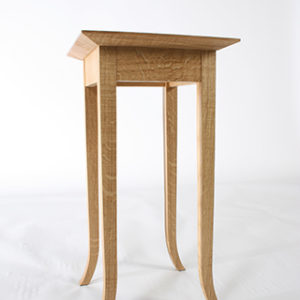Hi all
Ive seen this table that I really like, but can’t get my head round how to make these legs in particular the curved bottom portions. I guess you could make each leg out of a single piece of wood but with the taper and the curve this would surely result in considerable waste that I’m not sure I could live with. I could also see how you could make the lower section as a separate piece but how would you join it so it is sufficiently strong.
Appreciate any thoughts and guidance
Cheers















Replies
I haven't gotten into steam or hot water bending, but if I had to do this... Anyway look up articles in FWW - Boggs, Galbert and many others.
It’s a modern version of a Cabriole leg that is cut from a 2 1/2 ´ ´ or 3 ´ ´ square on the bandsaw, you could imagine starting With a 2 inches square and laminating an extra thickness at the bottom but will need to support the upper part for bandsawing.
The only way I have seen that leg made is as Gulfstar said. 2-1/2 to 3 inch stock, bandsawn to shape, just as a more traditional Queen Anne leg. Easy as pie. Cut the joinery first, bandsaw to shape, clean up the flats. Looking at the grain on these legs, that's how they did it.
It's a little wasteful of stock, but most every curve is. Steambending chair parts ends up with a lot bigger percentage of a lot on the burn pile though.
You could glue some blocks on the bottom of 1-1/2 inch squares, then bandsaw. More time, less waste. If I was painting this, I might. But likely not. On a clear finish, I would see the glue line every time I looked at it, and hate myself for doing it.
It's possible to make forms and do compound bends. It would be nuts to do so. Tons of work and time, and the results may be sub par.
Nice table! This is how I would approach it:
Those legs were cut from solid stock at least as thick as the diagonal of the top of the leg. There will be waste. To minimize it, make 2 blanks a bit longer than the legs so you can nest a pair of legs overlapping head-to-toe.
The backs corners of the legs will become your referance surfaces, so after jointing the blanks run both edges through the tablesaw with the blade at 45* to form them.
Once you have the back edges sorted head to the bandsaw to seperate into individual legs. Lots of handwork from there...or maybe an elaborate sled to run part of the front corners on a machine.
When you choose your stock keep in mind that the grain direction of the board you start with is off by 45* with this approach. A flatsawn board will produce riftsawn legs.
Judging by the figure they are from a single blank. There is always another way to skin the cat but, the resulting "look" would be different. Not bad, just different.
Thank you everyone for your feedback.
Made a hall table with similar design. For each leg, you glue up two riftsawn triangle blanks to make a square blank that covers the entire footprint -- this ensures a uniform grain pattern throughout the bottom curve.
Then tape the leg template on the blank and bandsaw away the waste. Yes, lots of waste. Tape the waste piece back on, rotate, and bandsaw the other face. The resulting flowing grain pattern down the whole leg is worth the effort.
@Elmaduro, please post a sketch of one of the triangles to show grain direction? Does the glueline run through the toe? A closeup of a foot would be great if available.
Don't have the hall table anymore as it was a long ago project. But here are the steps and hope they help. Diving back into the archives, this project is from Woodsmith Vol. 25, Issue 147, June 2003.
Thanks Elmaduro, a nice solution for thinner stock. There is an overstuffed drawer in my brain for such things. For some reason it opens in winter and sticks in summer....
That is a lot of effort to get an even grain pattern. Starting with a glued up 3 1/2 inch square to end with a 2 1/4 inch square trows away one third of the wood before the band saw operation, but yes the grain pattern is even, as if you would have used wood with the growth ring at 45 degrees from the surface.
MJ....Been there, doing that.
Gulfstar, my take away is cutting triangular blanks from 1.5" flatsawn stock, just flipping the board back and forth and avoiding that first stage of milling. Probably double the leg yield fron the board. I agree that the woodsmith instructions are hugely wasteful.
Nope, same yield, actually less since to get 1,5 inches thick jointed you will need to start with 8/4 stock. Unless the board is wide enough to make several triangles, say a 10 inch wide board will yield 5 triangles, but the grain is unlikely to be flat sawn over the 10 inches width.
This forum post is now archived. Commenting has been disabled